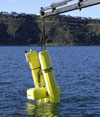 Welcome to the ninth post in the Sustainable Energy without the Hot Air – A New Zealand Perspective series. Today we’re summarising the numbers on the various renewable energy options in New Zealand (and finding they’re more than sufficient!). For the background to the work please our introductory post here. Also check out our earlier posts on the potential of hydro power, geothermal and wind, and the summary on the big three. More recently we’ve dealt with solar, biofuels, marine and waste energy. Note: the units are in kWh/day/person – ie. if you ran a 40W lightbulb for 24 hours, it’d take ~1 kWh over the space of a day. We then divide it by person to give you a sense of the scale of the resource proportionate to the size of the population. Be sure to check out the methodology. For reference – we’re looking to replace around 55 kWh/d/p of energy currently generated by fossil fuels.
Welcome to the ninth post in the Sustainable Energy without the Hot Air – A New Zealand Perspective series. Today we’re summarising the numbers on the various renewable energy options in New Zealand (and finding they’re more than sufficient!). For the background to the work please our introductory post here. Also check out our earlier posts on the potential of hydro power, geothermal and wind, and the summary on the big three. More recently we’ve dealt with solar, biofuels, marine and waste energy. Note: the units are in kWh/day/person – ie. if you ran a 40W lightbulb for 24 hours, it’d take ~1 kWh over the space of a day. We then divide it by person to give you a sense of the scale of the resource proportionate to the size of the population. Be sure to check out the methodology. For reference – we’re looking to replace around 55 kWh/d/p of energy currently generated by fossil fuels.
So we’ve gone through the various renewable energy options over the last week or so. So where does this leave us for increased generation potential among renewable options? The affordable, mature technologies are hydro, geothermal, wind, waste gas, solar heating and biofuel. Large-scale solar and marine technologies are really promising options for the future but cannot be realistically considered now.
Continue reading “Sustainable Energy NZ #9 – Here Comes the Sum – what are renewables worth?”

 Welcome to the eighth post in the Sustainable Energy without the Hot Air – A New Zealand Perspective series. Today we’re crunching the numbers on marine and waste incineration potential in New Zealand. For the background to the work please our introductory post
Welcome to the eighth post in the Sustainable Energy without the Hot Air – A New Zealand Perspective series. Today we’re crunching the numbers on marine and waste incineration potential in New Zealand. For the background to the work please our introductory post 
 Welcome to the sixth post in the Sustainable Energy without the Hot Air – A New Zealand Perspective series. Today we’re crunching the numbers on solar potential in New Zealand. For the background to the work please our introductory post
Welcome to the sixth post in the Sustainable Energy without the Hot Air – A New Zealand Perspective series. Today we’re crunching the numbers on solar potential in New Zealand. For the background to the work please our introductory post